 Open Access
Open Access
ARTICLE
Influential Factors of Suicidal Ideation among University Students—The Moderating Role of Family Closeness and Peer Support
1 School of Humanities and Education, Nanchang Institute of Technology, Nanchang, 330044, China
2 School of Languages and Media, Anhui University of Finance & Economics, Bengbu, 233000, China
* Corresponding Author: Jinling Wang. Email:
International Journal of Mental Health Promotion 2025, 27(4), 485-505. https://doi.org/10.32604/ijmhp.2025.059951
Received 21 October 2024; Accepted 19 February 2025; Issue published 30 April 2025
Abstract
Objectives: Suicidal ideation (SI) among university students is a growing concern, influenced by anxiety, depression, and bullying. However, family closeness and peer support may act as protective factors, reducing the risk of SI. Therefore, this study aims to investigate the key factors influencing SI among university students, focusing on the effects of anxiety, depression, and bullying, along with the roles of family closeness and peer support. The research also explores the interactions and mechanisms between these variables. Methods: A sample of 318 university students was surveyed, evaluating six main factors: anxiety, depression, bullying, family closeness, peer support, and SI. Using the Structural Equation Modeling (SEM) and Artificial Neural Networks (ANN) approach, both compensatory and non-compensatory relationships were examined. Results: Anxiety, depression, and bullying significantly contribute to SI, with depression mediating the link between anxiety, bullying, and SI. Additionally, family closeness moderates the effects of anxiety and bullying on SI, while peer support moderates the effects of depression and bullying. The multilayer perceptron analysis identifies peer support as the most influential predictor, followed by bullying, family closeness, depression, and anxiety. Conclusion: The study identifies anxiety, depression, and bullying as key factors influencing suicidal ideation (SI) among university students. Family closeness and peer support act as protective factors, moderating the effects of these variables on SI.Keywords
The issue of university student suicide has gained global attention, with rates increasing and becoming a significant public health issue [1]. Suicidal ideation (SI), described as an individual’s extreme di50.
Stress and loss of desire to live [2], is a critical predictor of suicidal behaviors among students [3]. Studies show that suicide is now a leading cause of death for individuals aged 15–34 in China, especially among university students, with 4.7 per 100,000 dying by suicide [4,5]. SI is considered a crucial precursor to suicidal actions [6], and individuals with SI are three times more likely to attempt suicide than those without [7]. Therefore, identifying SI and its predictors is essential for early intervention and preventing suicidal behaviors in university students.
SI is shaped by a mix of internal factors, such as personality traits [8], cognitive styles [9], mental and physical health status [10], and genetic factors [11], among which anxiety [12], depression [13], and sleep quality [14] play significant roles. External factors such as family background, school environment, and negative life events, including family conflicts [15], parental upbringing styles [16], bullying experience (BE) [17,18], and exam failure also significantly impact university students’ SI. Recreational engagement and physical activity, recognized as important protective factors against SI [19], are often overlooked in prior research. Moreover, with the rapid rise of social media usage, distinguishing between online and in-person bullying has become increasingly relevant, as these forms may have varying impacts on SI [20]. However, this study does not differentiate between online and in-person bullying, focusing instead on the overall impact of bullying experiences on SI to provide a generalizable framework.
1.1 Anxiety and Suicidal Ideation (SI)
Adolescent anxiety has drawn considerable attention, and in university students, anxiety manifests as worry, tension, and unease about future prospects, negatively affecting their mental health and increasing psychological risks [21]. Anxiety is described as the feeling of worry, tension, and unease about future events [22], and is a common negative emotion among university students [23]. Recently, researchers have focused more on the potential impact of university students’ anxiety on SI [24–27]. SI refers to an individual’s subjective, intermittent or continuous loss of desire to live, coupled with significant distress about life, yet without concrete actions of suicide [2]. For example, Lee et al. [26] found that higher levels of anxiety are linked to an increased risk of SI in adolescents. Tan et al. [25] also examined how social anxiety directly and indirectly affects SI in adolescents, finding that social anxiety significantly contributes to SI.
1.2 Depression and Suicidal Ideation (SI)
Depression is commonly characterized by persistent sadness, loss of interest, and feelings of helplessness [28]. Depression affects university students’ academic performance and social interactions and may also lead to serious psychological issues like SI [29]. Numerous studies highlight a significant link between depression and SI in university students [28,30–32]. Lee et al. [31] found that depression, positively associated with higher levels of secondhand smoke exposure, significantly increased the likelihood of SI. Similarly, Chinawa et al. [32] found that depression significantly increased the likelihood of SI among adolescents, with 21.7% of those with depression experiencing SI compared to 9.4% among those without depression. Hence, in this research, depression is considered a major factor contributing to SI among university students.
1.3 Bullying Experience (BE) and Suicidal Ideation (SI)
University students may face various forms of BE, such as physical harm, verbal harassment, and exclusion from social groups [33]. Studies show a strong correlation between BE and SI [34,35]. For example, Husky et al. [34] found that bullying significantly increases the likelihood of SI in children aged 6–11, with 19.6% of bullies and 24.4% of bully-victims reporting SI. Additionally, Cao et al. [35] observed that bullying victimization significantly increased the risk of SI in adolescents, with more frequent and severe bullying associated with higher SI levels. The study also found gender and grade differences in the relationship. In this study, university students with bullying experiences on campus reported higher levels of SI.
1.4 The Mediating Role of Depression
Depression plays a key mediating role between anxiety, BE, and SI. Research has shown a strong correlation between anxiety and depression, which both negatively affect college students’ mental health [36,37]. Particularly in early adolescence, anxiety and depression often co-occur, leading to harmful outcomes such as self-harm, SI, and behaviors [36,38]. Hill et al. [39] demonstrated that depression mediates the relationship between anxiety and suicidal thoughts or behaviors in university students. Anxiety is associated with the development of depressive symptoms, which in turn increase the risk of SI. In this study, anxiety not only directly contributes to SI but also exacerbates depression, thereby further elevating the risk of SI.
Additionally, BE is closely associated with both depression and SI. Studies have shown that college students who experience bullying are more likely to develop depression, with depression serving as a key mediator between BE and SI [40–43]. Ni et al. [43] found a positive association between bullying and depression among college students. BE is strongly linked to depression, with personality traits partially mediating this relationship. depression acts as a critical mediator between BE and SI [44,45]. For instance, a study by Zhao et al. [45] on 1814 Chinese high school students found that depression mediated the relationship between BE and SI without significant gender differences. Similarly, Chu et al. [44] established a mediation model with BE, depression, and SI in a sample of 1509 Chinese university students. The results suggested that those subjected to long-term bullying were more prone to develop depression, which is associated with an increased likelihood of SI. This study finds that university students with BE display more severe depression symptoms and heightened SI.
1.5 The Moderating Role of Familial Closeness (FC)
Family closeness pertains to the emotional connection among family members, characterized by respect, support, and mutual aid [46]. Research has shown that FC plays a critical role in reducing the impact of anxiety, depression, BE, and SI among university students [47,48]. In their study on 520 Chinese university students, Sun et al. [47] found that students with higher FC were better able to manage emotions like depression and anxiety, exhibiting lower levels of SI. Lardier et al. [48] also found that FC acts as a buffer against the negative effects of bullying, with students experiencing fewer SI symptoms despite bullying. In this study, strong family connections were associated with better emotional balance and mental health.
1.6 The Moderating Role of Peer Support (PS)
PS, as a crucial aspect of social support, consists of emotional and material resources that individuals receive from their peers, which help them cope with stress. Rubio et al. [49] found that PS plays a key role in reducing the effects of depression on SI. PS helps individuals with anxiety or depression seek help, reducing their risk of SI. Similarly, Oon-arom et al. [50] found that strong PS helps anxious individuals lower their SI levels. Bao et al. [51] showed that PS moderates the relationship between BE and SI among Chinese university students. Students with strong PS showed fewer SI symptoms when experiencing anxiety, depression, and BE.
Despite growing research, many studies focus on limited factors like anxiety, depression, and BE [32,52], overlooking the complex interactions between internal and external influences. FC and PS are protective against SI [53,54], but their specific moderating roles are underexplored. This study incorporates anxiety, depression, BE, FC, and PS to better understand these interactions and create a more comprehensive model of SI.
Current research methods mainly use linear approaches like PLS-SEM and Conditional Process Analysis (CPA) [55], but these struggle to capture non-linear interactions. To address this, advanced methods such as Artificial Neural Networks (ANN) [56] are being employed, although ANN lacks interpretability. This study combines PLS-SEM and ANN to provide a balanced approach, overcoming the limitations of traditional methods and gaining deeper insights into the factors influencing SI.
Aims and hypotheses
This study develops a comprehensive predictive model that includes both internal factors like anxiety and depression, and external factors such as FC, PS, and BE. The research objectives are: (1) to analyze the key factors affecting university students’ SI using SEM; (2) to build a high-performance predictive model using ANN. Key research questions include:
(1) What factors significantly affect SI in university students?
(2) Does depression mediate the relationship between anxiety, BE, and SI?
(3) Do FC and PS moderate the relationships between anxiety, depression, BE, and SI?
(4) What is the relative importance of the factors influencing SI?
The hypotheses proposed for this study include:
H1: anxiety has a positive effect on SI.
H2: depression has a positive effect on SI.
H3: BE has a positive effect on SI.
H4: depression mediates the relationship between anxiety and SI.
H5: depression mediates the relationship between BE and SI.
H6: FC moderates the relationship between anxiety and SI.
H7: FC moderates the relationship between depression and SI.
H8: FC moderates the relationship between BE and SI.
H9: PS moderates the relationship between anxiety and SI.
H10: PS moderates the relationship between depression and SI.
H11: PS moderates the relationship between BE and SI.
Based on the research hypotheses mentioned above, this study proposes a conceptual model, as shown in Fig. 1, which examines the moderating effects of FC and PS on the relationships between high school students’ anxiety, depression, BE, and SI.
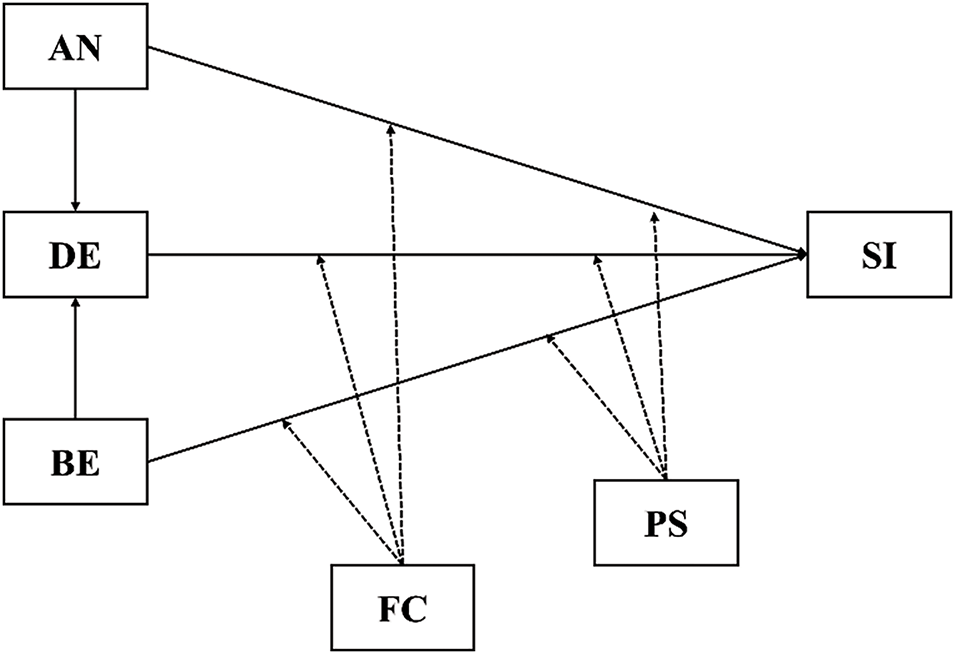
Figure 1: Research model
2.1 Samples and Data Collection
Data for this research were collected using the online platform Questionnaire Star (www.Sojump.com) between June and November 2023. We employed a random sampling method by collaborating with teachers from various classes at universities in Shandong, Hubei, and Anhui provinces, China. Teachers introduced the questionnaire to students and randomly selected participants to ensure a representative sample. After sharing the questionnaire link in-class group chats, students voluntarily completed the survey. A total of 366 questionnaires were collected, and the data from 48 participants were excluded for the following reasons: (1) incomplete responses, defined as questionnaires with missing responses to more than 20% of the items (valid questionnaires were defined as those in which ≥80% of the items had been completed); or (2) respondents who completed the questionnaire with an average response time of less than 1 s per question, indicating a lack of serious engagement. Consequently, the data from 318 valid questionnaires were included in the final analysis [57]. According to Barclay et al. [58], the minimum sample size for PLS-SEM is ten times the number of arrows pointing at latent variables. With a maximum of three arrows in our model, a minimum of 30 responses was required. Our sample of 318 exceeds this requirement, ensuring adequate statistical power. The demographic breakdown is detailed in Table 1: 184 males (57.9%), 134 females (42.1%), predominantly aged 18–20 (68.6%), including 190 first-year students (59.7%), 55 second-year students (17.3%), and 43 third-year students (13.5%).
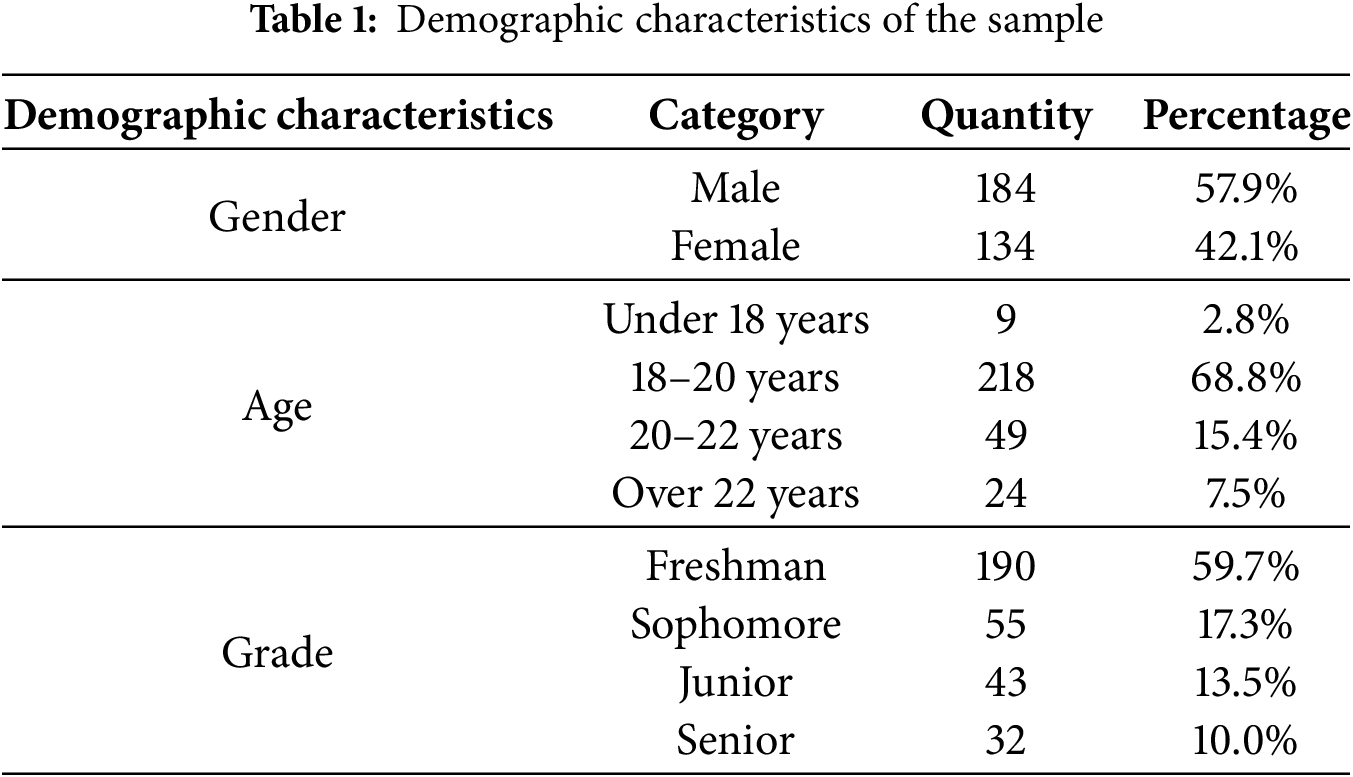
This study was approved by the Ethics Committee of School of Nanchang Institute of Technology, Ethics approval number: NIT-2023-01-0016. The participants received oral and written information and provided written informed consent before participating in the study.
The questionnaire was structured in two sections. The first section collected demographic details of the respondents, while the second section evaluated the constructs central to this research. All constructs utilized well-established scales, which were modified where necessary to align with the research context and objectives. Apart from demographic-related factors, the constructs were measured using a five-point Likert scale, where responses ranged from (1) “Never” to (5) “Always.”
To assess students’ anxiety, seven items from Zheng et al. [27] were employed (e.g., “I often feel anxious and nervous”). This scale has also been widely used in China and shows good reliability and validity [59]. In this study, Cronbach’s Alpha Coefficient for this scale was 0.912. The depression construct was measured with five items from Dhir et al. [60] (e.g., “I often feel lonely”). In this study, Cronbach’s Alpha Coefficient for this scale was 0.887. The scale developed by Li et al. [61] was utilized to assess views on BE (e.g., “Others have teased me, saying hurtful things”). In this study, Cronbach’s Alpha Coefficient for this scale was 0.958. For FC, fifteen items from Ghahvehchi-Hosseini et al. [62] were adopted (e.g., “In times of family difficulties, everyone makes efforts to help one another”). In this study, Cronbach’s Alpha Coefficient for this scale was 0.904. Thirteen items from Wei et al. [63] were used to evaluate PS (e.g., “My classmates tend to curse at one another”). In this study, Cronbach’s Alpha Coefficient for this scale was 0.861. The SI construct was assessed using fourteen items from Zheng et al. [13] (e.g., “I feel hopeless about the future and experience thoughts of suicide”). In this study, Cronbach’s Alpha Coefficient for this scale was 0.938.
This study employed a two-stage approach to test hypotheses and build a predictive model. First, the theory-driven SEM was mainly used to detect linear relationships between exogenous and endogenous variables, applying a compensatory model, where a decrease in one variable is offset by an increase in others [64]. SEM was implemented using SmartPLS 4.0. Path analysis and bootstrapping were used for hypothesis testing. However, the relationships between anxiety, depression, BE, FC, and PS with university students’ SI are not purely linear or compensatory. Compared to SEM, ANN can model both linear and non-linear relationships, utilizing a non-compensatory approach [65], thus improving predictive performance. Given the “black box” nature of ANN, it is better suited for prediction tasks and can complement the results obtained from SEM. Therefore, this study combined both methods for hypothesis testing and prediction. The ANN analysis was conducted using Python (version 3.8), which can model both linear and non-linear interactions without requiring normal data distribution.
In the first phase, SEM was used to analyze the effects of anxiety, depression, BE, FC, and PS on SI and to identify key predictors. In the second phase, these significant predictors were used as input neurons in the ANN to forecast SI, ultimately yielding accurate predictions and a ranking of influential factors.
In this study, the PLS-SEM method was used to test the measurement model and the structural model. PLS-SEM has several advantages: first, it is a predictive-oriented data analysis tool [66]; second, it is suitable for small sample data and performs well even in non-normal distributions [66]; third, it is applicable to comparatively complex models [67]. The purpose of this study is to predict the factors influencing SI among university students, with only 318 participants. Furthermore, the model includes 6 constructs with a total of 71 items, which is quite complex. Therefore, PLS-SEM is deemed appropriate for this study.
Based on Hair et al. [66], the study assessed the reliability and validity of the scales through measurement model analysis. Reliability was evaluated using external loadings and composite reliability (CR). While the ideal threshold for loadings is 0.708, FC3 and FC5 showed values of 0.607 and 0.673 (Table 2), respectively. However, items with loadings between 0.4 and 0.7 can be retained if the average variance extracted (AVE) and CR meet the required levels [66]. Therefore, FC3 and FC5 were kept. Internal consistency reliability was confirmed with all CR values exceeding the 0.708 guideline [66]. Therefore, FC3 and FC5 were retained in this research. Internal consistency reliability was evaluated using composite reliability, and all values exceeded the 0.708 guideline [66]. Validity was examined through convergent and discriminant validity. Convergent validity was assessed using AVE, which needed to be greater than 0.5. Discriminant validity was confirmed through the Fornell-Larcker criterion (Table 3) and the Heterotrait-Monotrait (HTMT) ratio (Table 4), with all values meeting the required thresholds. Thus, the constructs exhibited strong validity [66].
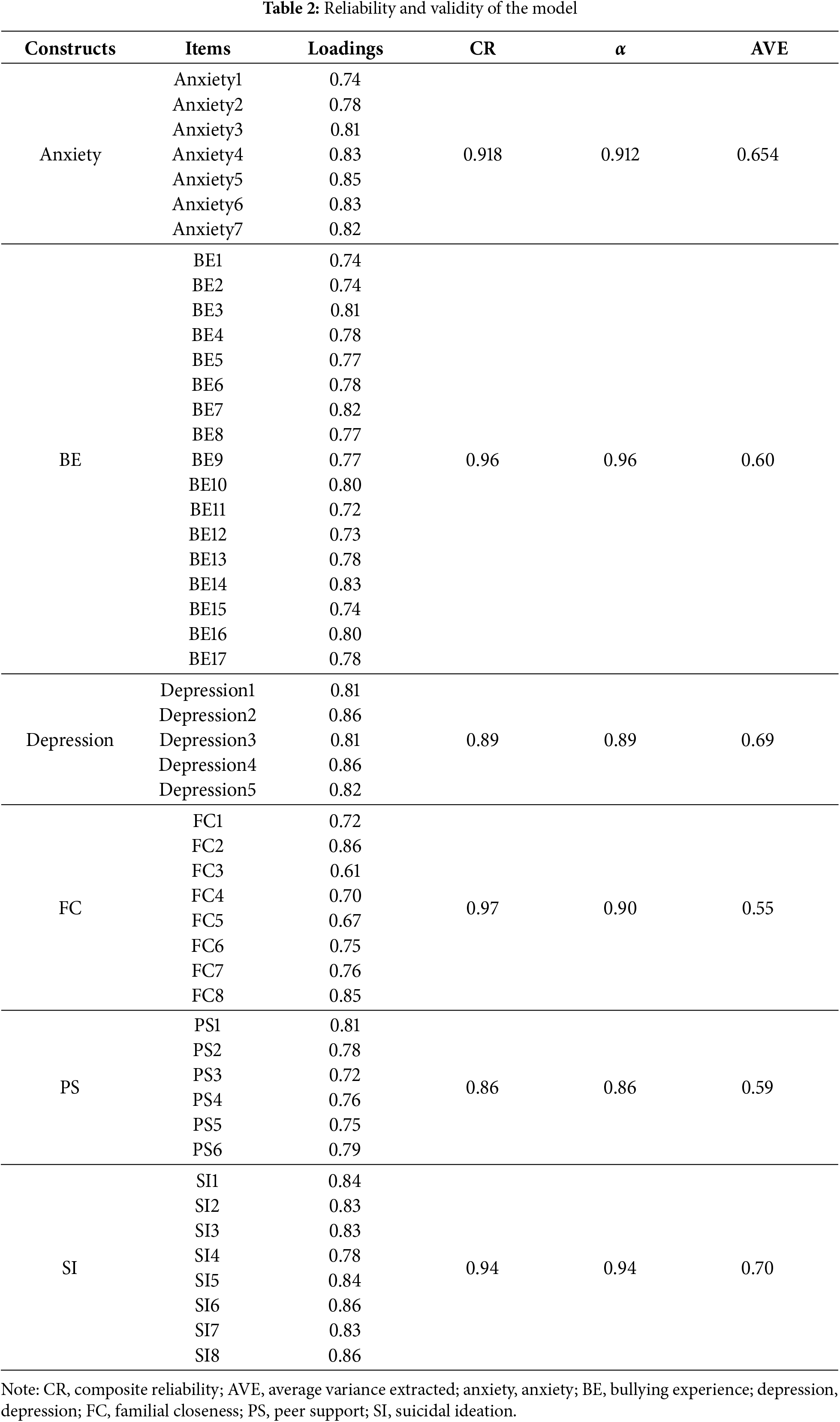
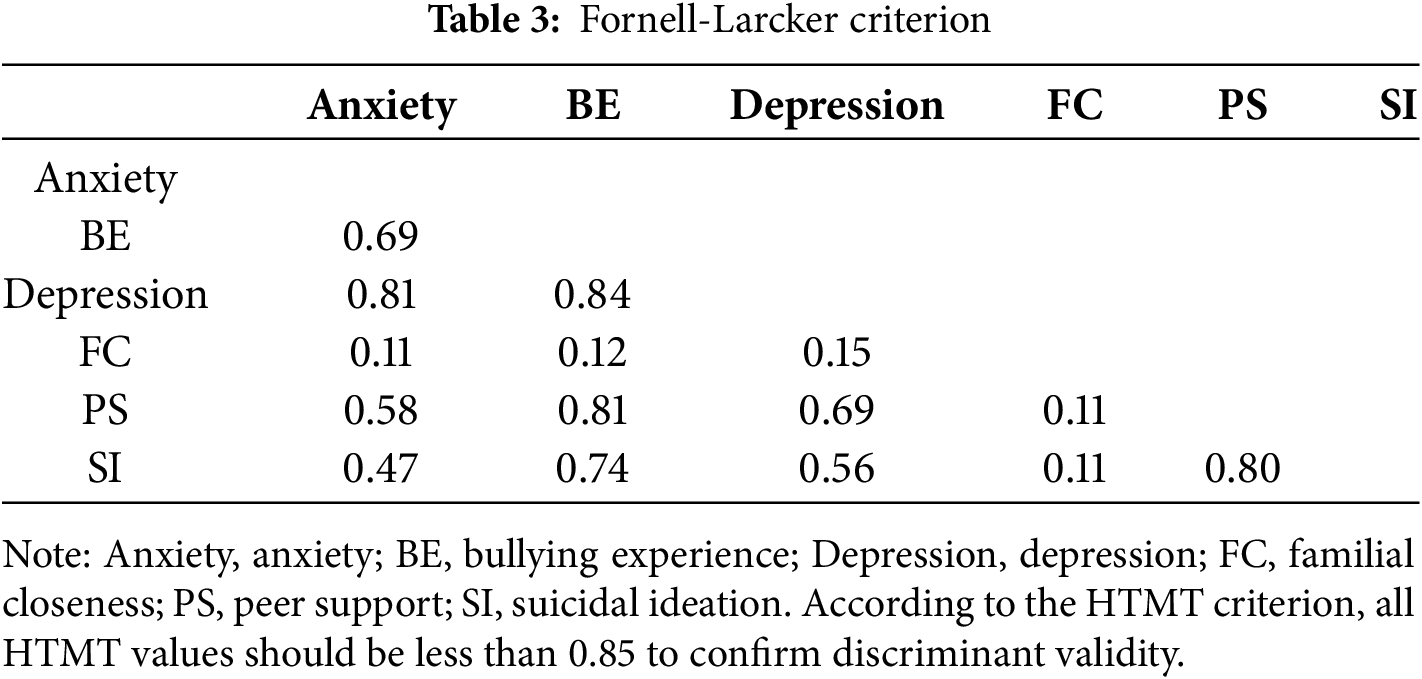
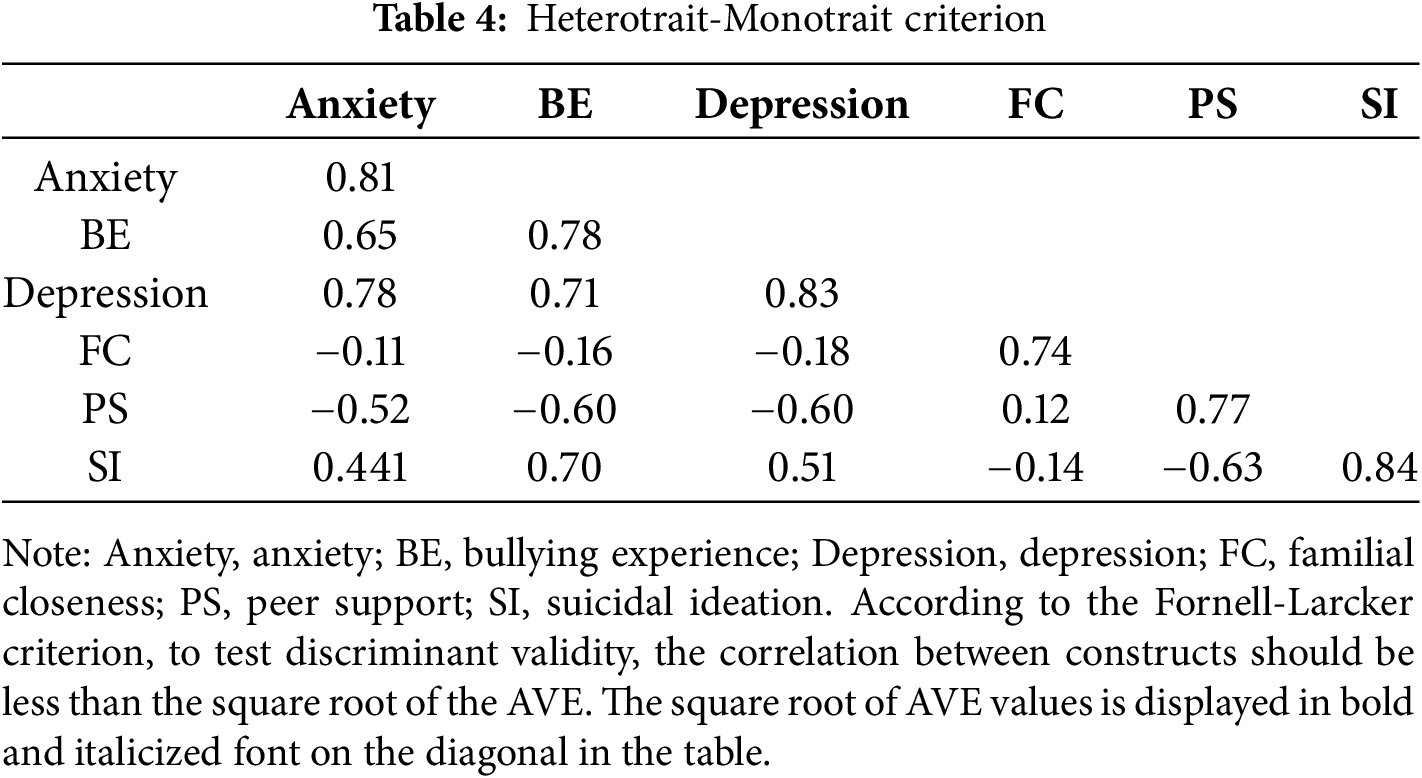
3.1.2 Common Method Bias (CMB) Test
To test for common method bias (CMB), this research utilized two methods. First, the Harman single-factor test showed that no single factor explained a majority of the variance, with the largest factor accounting for only 28.259%, well below the 50% threshold. Additionally, the marker variable technique introduced an unrelated variable, revealing a maximum shared variance of just 2.68% [68]. These results suggest that CMB is not a significant issue in this study.
Initially, the multicollinearity issue in the model was assessed using the Variance Inflation Factor (VIF) values for the latent constructs [66]. All latent constructs’ VIF values were below the critical value of 3.3, indicating no multicollinearity issues in the results [66]. The VIF values in Table 5 show that multicollinearity does not impact the results of this study.
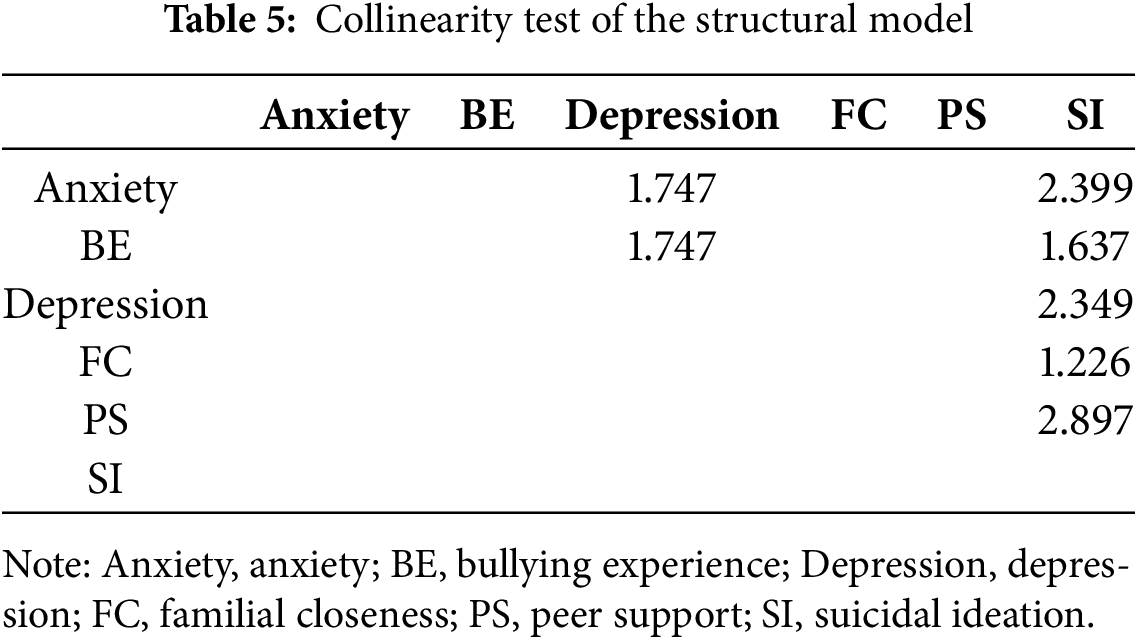
To assess the magnitude and significance of path coefficients in the model, a PLS bootstrapping process with 5000 subsamples was conducted [66]. Table 6 summarizes the results of the hypothesis tests.
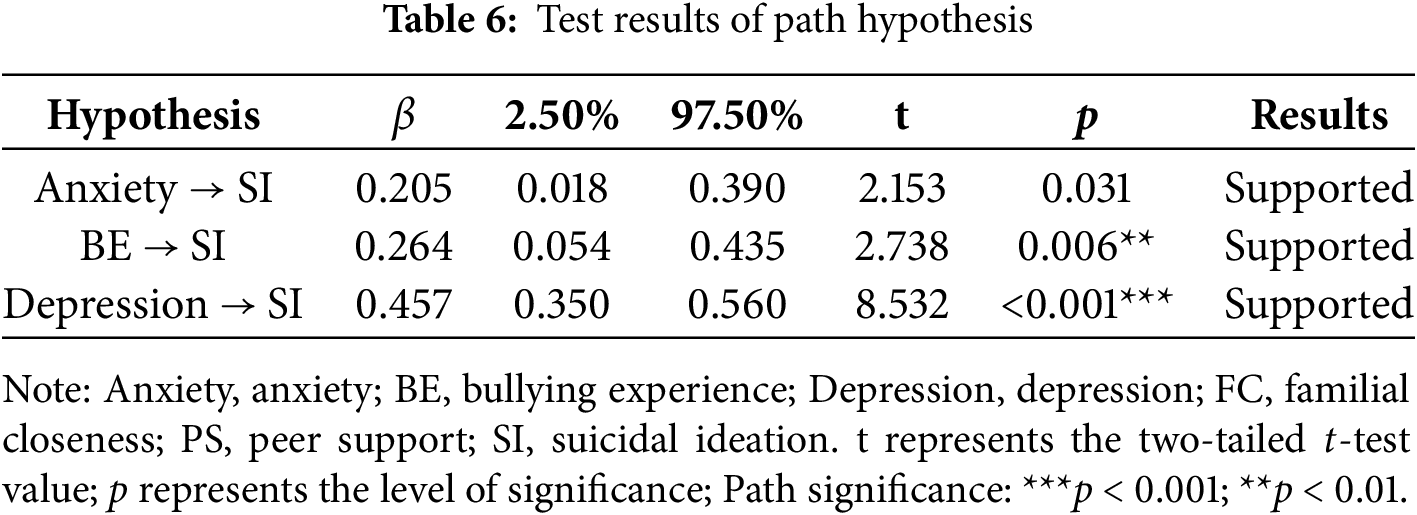
Table 6 demonstrates that all the proposed hypotheses were confirmed. Regarding the significant predictors of SI, depression (β = 0.457, t = 8.532, p < 0.001) emerged as the most influential factor, followed by BE (β = 0.264, t = 2.738, p = 0.006) and anxiety (β = 0.205, t = 2.153, p = 0.031). Similarly, in terms of predictors of depression, anxiety (β = 0.551, t = 10.857, p < 0.001) had the most substantial influence, followed by BE (β = 0.415, t = 8.870, p < 0.001).
Moreover, the R2 values and Stone-Geisser’s Q2 values of the endogenous variables indicate the model’s explanatory strength and predictive relevance, respectively [66]. The R2 values (refer to Table 7) suggest that the model has adequate explanatory capability. Specifically, the R2 value for SI reveals that the predictors account for 64.8% of the variance in SI. Similarly, the R2 value for depression shows that approximately 74.4% of the variance in depression is explained by its predictors. Additionally, as all Q2 values are greater than 0.4 (refer to Table 7), it signifies that the model has high predictive relevance.

Mediation analysis was conducted to evaluate the mediating effects of depression on the relationships between anxiety, bullying experiences, and suicidal ideation. A bootstrap-based mediation analysis using PLS-SEM was performed [69]. The significance of the direct and indirect effects, as well as the product of effects, was examined to determine the type and magnitude of the mediation effects. The results of the mediation analysis are summarized in Table 8.

The findings revealed that depression serves as a mediator in the relationships between anxiety, bullying experiences, and suicidal ideation. Direct effects were analyzed to assess the nature and size of the mediation effects of anxiety and bullying experiences. Anxiety partially mediated the relationship with suicidal ideation through depression, with a Variance Accounted For (VAF) value of 55.1%. Similarly, bullying experiences partially mediated the relationship with suicidal ideation through depression, with a VAF value of 41.9%. These results indicate that depression plays a partial mediating role in both scenarios [69].
3.4 Analysis of Moderating Effects
This research utilizes a two-phase method to analyze the moderating roles of PS and FC on the relationships between anxiety, depression, BE, and SI. The two-phase approach is widely applicable and considered more accurate than other methods like the Product Indicator and Orthogonalizing Approaches [70,71]. As shown in Table 9, FC significantly moderates the relationship between anxiety and SI (β = 0.096, t = 3.139, p = 0.002), while PS moderates the relationships between BE and SI (β = 0.072, t = 1.987, p = 0.047) and between depression and SI (β = 0.073, t = 4.128, p < 0.001). Additionally, FC moderates the link between BE and SI (β = 0.084, t = 1.968, p = 0.049). However, neither FC nor PS shows significant moderating effects on the relationships between depression and SI or anxiety and SI.
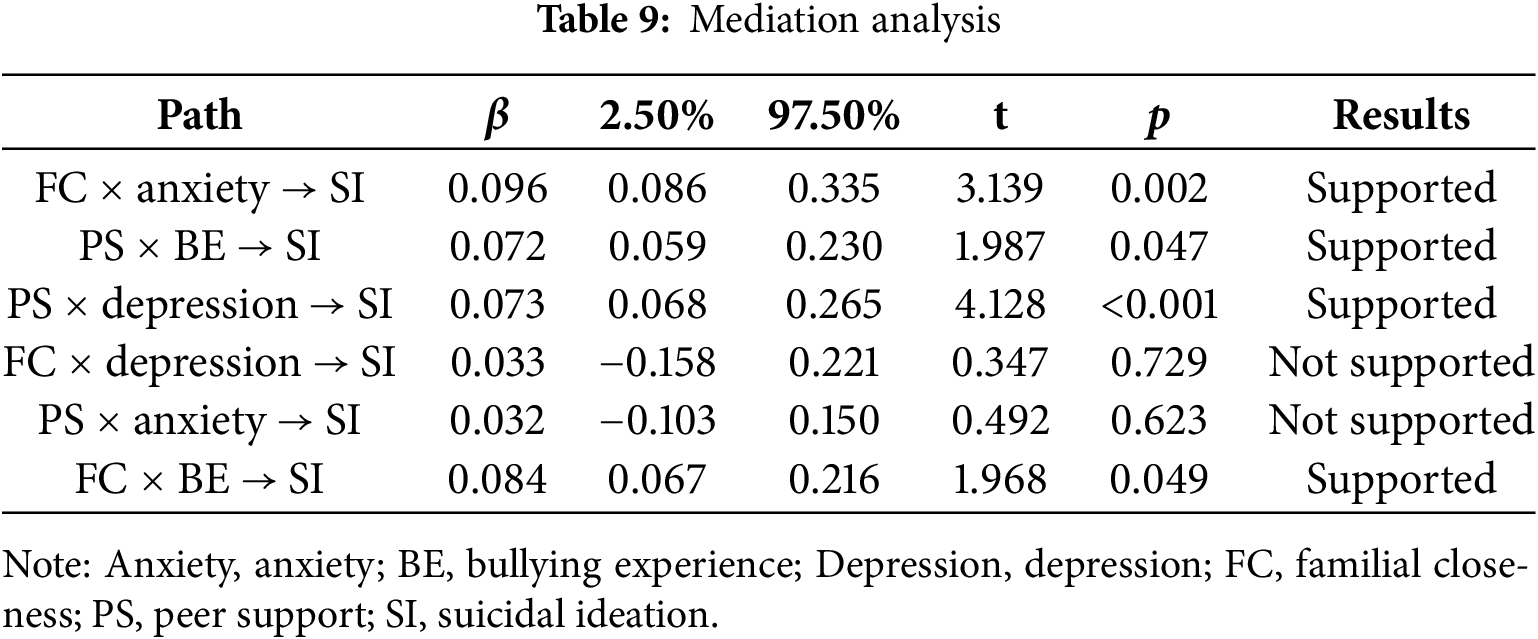
3.5 Artificial Neural Networks (ANN)
In the next phase, the significant factors identified from PLS-SEM path analysis were used as input neurons for the ANN model. The choice of ANN is based on its ability to handle non-linear relationships, non-normal data distributions, and its robustness against noise and small sample sizes. ANN also supports non-compensatory models where changes in one factor don’t necessitate adjustments in others. The ANN analysis was conducted using the IBM SPSS Neural Network module (version 28), which can detect both linear and non-linear interactions without requiring normal data distribution. The model utilized a feedforward-backpropagation (FFBP) process for prediction purposes [72], applying multilayer perceptrons and sigmoid activation functions in the input and hidden layers [73]. The iterative learning process aimed to minimize errors and improve accuracy. Following Leong et al. [64], 80% of the data was used for training, while 20% was reserved for testing. To prevent overfitting, a ten-fold cross-validation was performed, and root mean square error (RMSE) values were calculated. Table 10 shows that the RMSE for training and testing were 0.1072 and 0.1069, respectively, indicating a good fit.
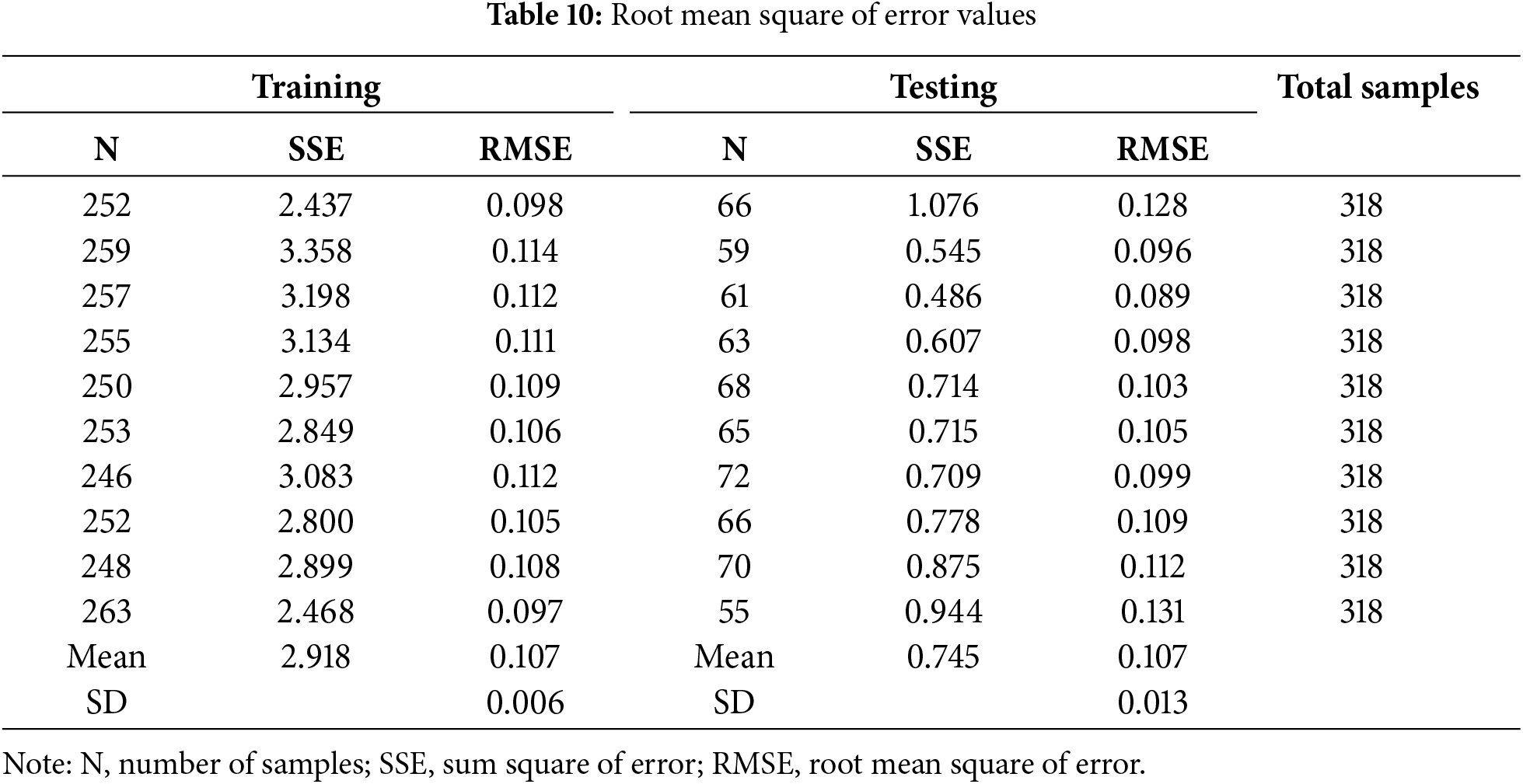
To evaluate the predictive strength of each input neuron, a sensitivity analysis was performed (see Table 11). The normalized importance of each neuron was calculated by dividing its relative importance by the highest importance value and expressing the result as a percentage. The findings show that PS is the most significant predictor with a normalized importance of 100.0%, followed by BE at 60.3%, FC at 13.2%, depression at 9.1%, and anxiety at 7.3%.
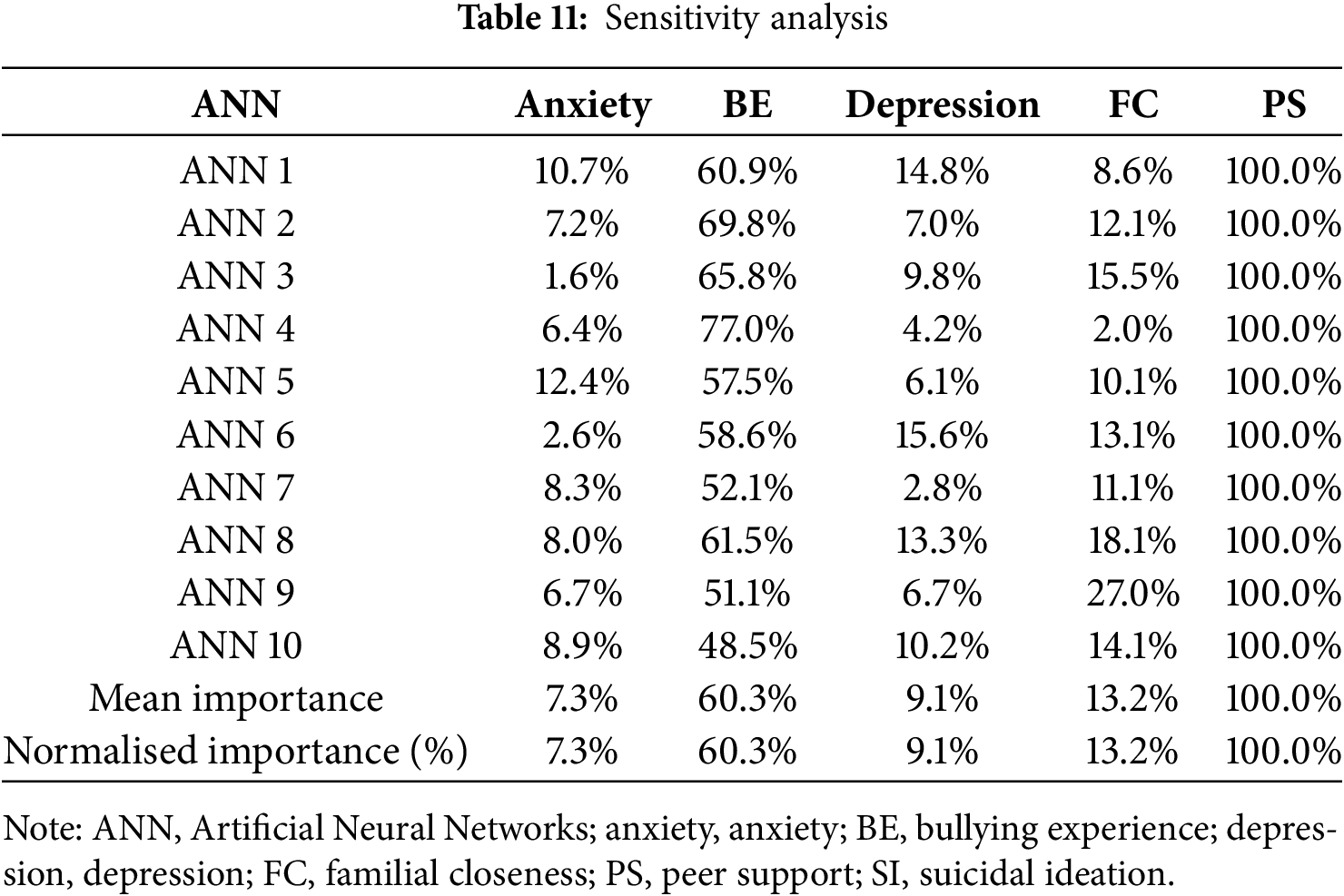
This study investigates the factors influencing SI in university students, with a focus on the mediating role of depression in the relationship between anxiety, BE, and SI. It also explores how FC and PS moderate the relationships between anxiety, depression, BE, and SI. The research hypothesizes that anxiety, depression, BE, FC, and PS are key predictors of SI. Except for the non-significant moderating effects of FC on the depression-SI link and PS on the anxiety-SI link, all other hypotheses were confirmed. Together, these factors account for 64.8% of the variance in SI among students. A detailed discussion of the findings and hypotheses is provided.
Anxiety among university students significantly positively affects SI. This aligns with the findings of Lee et al. [26]. Their cross-sectional study of 54,948 South Korean adolescents found that 33.2% reported anxiety symptoms, and 10.9% considered suicide, with anxiety significantly increasing the risk of suicidal ideation. In our study, on the one hand, prolonged anxiety may lead to a sense of isolation and social barriers [24], with anxiety symptoms often leading to emotional dysregulation and SI. On the other hand, anxiety among university students may result in excessive worry about the future, such as uncertainties about job prospects and career success [74], and this continued psychological stress can increase the risk of SI.
Depression among university students significantly positively affects SI, consistent with the findings of Lee et al. [31]. Their cross-sectional study of 51,500 adolescents found significant associations between stress, depression, and suicidal ideation, with risks increasing as mental health worsened. In our study, on one hand, depression greatly reduces life satisfaction among university students [75], leading them to lose enjoyment in life and consider suicide as a way to end suffering. On the other hand, depression can weaken individuals’ ability to cope with life challenges, leading to a pessimistic outlook on the future and increasing the risk of SI [30].
BE among university students significantly positively affect SI, aligning with the findings of Husky et al. [34] in their cross-sectional study on European school-aged children, which showed that children who experienced bullying had higher SI than those who did not. In our study, firstly, university students who BE often face severe social exclusion, humiliation, and fear, leading to deep psychological trauma [35] and subsequent SI. Secondly, during the rapid and sensitive phase of personal development in university, BE incidents can severely damage students’ self-identity and adaptability [76], potentially exacerbating psychological crises and increasing the likelihood of SI.
Depression mediates the relationship between anxiety and SI among university students. This finding is supported by the study of Hill et al. [39], which investigated the interrelations among anxiety, depression, perceived burden, and SI in university students. They found that anxiety among university students might indirectly increase the risk of SI by exacerbating symptoms of depression. In our study, firstly, academic pressures and uncertainties about the future often cause anxiety among university students, which, if not effectively managed, can develop into depression [37], thereby increasing the risk of SI through negative thinking. Secondly, social anxiety in university students, if mishandled, can lead to increased social isolation and symptoms of depression, making individuals feel more isolated and unsupported, leading to a decline in self-worth and increased SI [77].
Depression mediates the relationship between BE and SI among university students, consistent with the findings of 51 in their study involving 1509 undergraduates. Their research indicated that the mediating role of depression between BE and SI was more significant than core self-evaluations. In our study, firstly, university students who BE may feel isolated, significantly increasing the risk of depression. The lack of PS and positive recognition can lead to negative self-evaluation among students, thereby increasing the likelihood of SI [45]. Secondly, the psychological stress caused by BE can trigger or exacerbate depressive moods [78], leading victims to immerse in negative thoughts, thereby increasing the risk of SI.
The relationship between anxiety and SI among university students is significantly moderated by FC. This aligns with the conclusions of Sun et al. [47], who explored the factors influencing SI among Chinese university students. They found that in environments with FC, students could more effectively handle the negative emotions triggered by anxiety, thus reducing the risk of SI. In our study, firstly, students in environments with higher FC are more likely to receive emotional support and understanding [79], which not only alleviates the psychological stress caused by anxiety but also reduces the incidence of SI. Secondly, a supportive family environment helps students learn effective techniques to manage anxiety, such as understanding the root causes of anxiety through communication and empathy with family members and mastering corresponding coping strategies [80]. This positive interaction not only mitigates the direct impact of anxiety but also prevents it from evolving into more severe psychological issues, thereby effectively reducing the risk of SI.
FC does not significantly moderate the relationship between depression and SI among university students. This finding is inconsistent with the research by Zisk et al. [81], which, in a study of 129 university students facing depression and suicidal thoughts, found that FC played a significant moderating role in the relationship between depression and SI among university students. This discrepancy may be due to two reasons. Firstly, as university students grow more independent, their psychological and emotional states are increasingly influenced by personal experiences and social environments, with the direct impact of the family relatively diminished [82]. Secondly, university students increasingly seek help and support from peers and campus social networks [83], a trend that may lead to a relative weakening of the impact of FC in moderating depression and SI compared to broader social interactions.
FC significantly moderates the relationship between BE and SI among university students, aligning with the findings of Lardier et al. [48]. Their study found that among 687 students aged 16 to 18, those from close-knit families exhibited lower SI when facing campus BE. In our study, firstly, a high degree of FC helps students learn effective emotional regulation and coping strategies [84]. Thus, students can gain guidance from family members in dealing with the negative emotions and stress caused by BE, which is crucial in coping with the psychological challenges of BE. Secondly, a close family environment helps enhance individuals’ psychological resilience [84], allowing students to demonstrate stronger resistance and recovery capabilities when facing difficulties and stress. This resilience not only effectively mitigates the psychological trauma caused by BE but also reduces the risk of SI.
PS does not significantly moderate the relationship between anxiety and SI among university students. This differs from the findings of Oon-arom et al. [50], whose research on the factors influencing SI in the elderly indicated that PS significantly moderates the relationship between anxiety and SI. This difference could be due to two factors. On one hand, the pressure on academic and future career prospects faced by university students might far exceed the psychological comfort provided by PS [85], meaning that PS has limited effectiveness in alleviating these deeper anxieties. On the other hand, the widespread use of digital and social media has changed the way university students communicate and the nature of peer interactions. Online interactions in the digital society may not provide the same level of emotional support as face-to-face interactions [86], which could weaken the role of PS in moderating anxiety and reducing SI.
PS significantly moderates the relationship between depression and SI among university students, consistent with the conclusions of Rubio et al. [49]. Their in-depth study of 775 university students showed that PS plays a significant moderating role in the relationship between depressive symptoms and SI. In our study, firstly, when university students feel understood and supported by their peers, they are more efficient in handling negative emotions and setbacks, effectively reducing the risk of depressive moods evolving into SI. Secondly, PS, by providing positive feedback and encouragement, helps students find effective coping mechanisms and strategies in their depressive state [87], thereby effectively reducing the SI arising from depression.
PS significantly moderates the relationship between BE and SI among university students. This is consistent with the findings of Bao et al. [51], who conducted an in-depth survey on the school BE, SI, psychological distress, and PS among 2360 middle and high school students. Their research showed that with increased PS, the negative impact of school BE on SI gradually weakened. Firstly, PS provides an effective sense of psychological safety [88]. When university students feel accepted and supported by their peers, the psychological impact of BE can be alleviated, reducing the likelihood of BE transforming into SI. Secondly, PS also helps bullied students develop better social skills and coping strategies. These skills and strategies not only assist them in dealing with current BE issues [88] but also reduce the occurrence of future SI, as they learn how to communicate and resolve conflicts more effectively.
This study proposes a comprehensive model aimed at in-depth analysis of the key factors influencing university students’ SI. The model examines the effects of anxiety, depression, BE, FC, and PS on students’ SI, accounting for 64.8% of the total variance in these thoughts. Thus, the proposed model demonstrates high effectiveness in prediction and explanatory aspects. The results have both theoretical and practical impacts.
Firstly, the core contribution of this study is the development of an innovative comprehensive model, which uniquely integrates internal psychological states (such as anxiety and depression) with external environmental factors (like FC, PS, and BE). This unique perspective reveals the complex and multi-dimensional mechanisms affecting university students’ SI. The study provides new theoretical grounds and empirical support for understanding and preventing suicidal behaviors in university students. It also demonstrates how the interaction between individual psychological states and external social environments influences their SI.
Secondly, the study delves into and reveals the mediating role of depression between university students’ anxiety, BE, and SI, specifically elucidating the mechanism of this effect. It also analyzes the importance of FC and PS in modulating the relationships between these psychological factors. The study significantly expands the theoretical framework in the field of mental health regarding emotional regulation and psychological adaptability, emphasizing the critical role of social and familial support in the prevention and intervention of university students’ SI. By revealing the complex interplay between psychological dynamics and social factors in students, it offers a new perspective on the multifaceted causes of SI and lays a theoretical foundation for designing more effective mental health intervention strategies.
Lastly, this study diverges from existing linear model research, employing a two-stage method using SEM-PLS and ANN. This methodological innovation combines linear and compensatory PLS models with the non-compensatory ANN model. In the linear compensatory model, a decrease in one predictor can be offset by an increase in another. However, in the context of university students’ SI, such linear compensation is not always applicable. Specifically, a reduction in depression levels cannot simply be offset by an increase in BE. Therefore, by using the non-compensatory ANN model, this study not only overcomes the limitations of linear models but also contributes new theoretical insights to the existing literature. Additionally, the ANN model, by thoroughly analyzing the most critical variables, highlights their importance and confirms the data’s high predictive accuracy through neural network analysis.
For university students, the findings of this study underscore the importance of PS and FC. Students need to recognize that in coping with psychological challenges like anxiety and depression, FC and PS are indispensable resources. Establishing strong family ties and a positive social network is crucial in alleviating psychological stress caused by academic pressure, interpersonal conflicts, or BE. Moreover, students should learn how to effectively seek help when facing SI, whether it be from family members or trusted friends, as these are key steps in managing negative emotions and finding solutions.
For schools, on the one hand, they should actively create an environment that promotes positive communication and mutual assistance among students, encouraging open and honest dialogue so that students feel supported and understood when facing psychological challenges. On the other hand, schools should also value collaboration with families, regularly communicate with parents, and share strategies and resources to support students’ mental health, which is vital for building a comprehensive environment focused on students’ psychological well-being. Additionally, teachers need to be sensitive to students’ anxiety, depression, and BE, cultivating keen insight to effectively identify those who may be at risk of suicide.
For families, this study emphasizes the necessity of establishing a supportive and communicative environment, especially when dealing with university students’ anxiety and depression. Parents should encourage their children to share their feelings and experiences, providing necessary emotional support and guidance. Furthermore, parents’ active involvement in school activities and students’ lives is crucial, not only helping parents better understand their children’s social circles and school environment but also enabling them to collaborate with schools when necessary to support their children’s mental health and personal development.
4.2 Limitations and Future Research
This study explored the impact of factors such as anxiety, depression, BE, PS, and FC on university students’ SI. However, several limitations should be acknowledged. Firstly, the sample size of 318 participants may be relatively small for the application of ANN models, potentially limiting the generalizability of the results and increasing the risk of overfitting. Future research should consider increasing the sample size or employing alternative methods such as CPA to validate the findings and enhance methodological rigor. Secondly, this study primarily relied on questionnaire surveys for data collection, which may have restricted the depth of understanding of participants’ true SI. Questionnaire surveys based on self-reporting are prone to respondent subjectivity. Future studies could consider integrating in-depth interviews and case studies to obtain richer and more authentic data. Additionally, the selection of variables was mainly focused on specific psychological factors; future research could include more relevant predictors such as self-esteem and personality traits to construct a more comprehensive theoretical framework. Lastly, this study was cross-sectional and did not reveal the long-term changes in SI. Future studies should undertake longitudinal research to better understand the evolution and long-term impacts of these behaviors.
This study explored the factors influencing university students’ SI and further examined the mediating role of depression in the relationship between anxiety, BE, and SI. To ensure methodological rigor and address model complexity, the study employed both SEM and ANN, providing a robust analytical framework. A comprehensive rationale was provided for the selection of factors anxiety, BE, depression, FC, and PS, and additional relevant predictors were included to enhance the analysis. Empirical research was conducted using self-reported data from 318 university students to test 13 hypotheses. The results demonstrated that anxiety, depression, and BE all have a significant positive impact on students’ SI. Additionally, depression played a significant mediating role between anxiety, BE, and SI. Furthermore, FC had an important moderating effect in the relationship between anxiety, BE, and SI, while PS moderated the relationship between depression, BE, and SI, with the remaining hypotheses being validated. However, the relatively limited sample size may restrict the generalizability of the findings. Future research should consider increasing the sample size or exploring alternative methods such as CPA to validate the results and ensure greater methodological rigor. This study contributes to a deeper understanding of the relationships and potential mechanisms between university students’ anxiety, depression, BE, and SI, highlighting the distinct pathways through which these factors influence student engagement.
Acknowledgement: We would like to sincerely thank all the students who participated in the survey and the teachers who assisted in distributing the questionnaires for their valuable contributions to this research.
Funding Statement: The authors received no specific funding for this study.
Author Contributions: Conceptualization: Jun Qiu; Methodology: Jun Qiu; Formal analysis and investigation: Jun Qiu; Writing—original draft preparation: Jun Qiu; Writing—review and editing: Jinling Wang; Supervision: Jinling Wang. The corresponding author is Jinling Wang. All authors reviewed the results and approved the final version of the manuscript.
Availability of Data and Materials: The dataset supporting the conclusions of this study is available at Wang, J. (2024). Raw Data_Factors Influencing Suicidal Ideation Among Chinese College Students [Data set]. Zenodo. 10.5281/zenodo.14279327.
Ethics Approval: Ethics approval and consent to participate: The researchers confirms that all research was performed in accordance with relevant guidelines/regulations applicable when human participants are involved (e.g., Declaration of Helsinki or similar). This study was approved by the Ethics Committee of School of Nanchang Institute of Technology, Ethics approval number: NIT-2023-01-0016. The participants received oral and written information and provided written informed consent before participating in the study.
Conflicts of Interest: The authors declare no conflicts of interest to report regarding the present study.
References
1. Bridge JA, Ruch DA, Sheftall AH, Hahm HC, O’Keefe VM, Fontanella CA, et al. Youth suicide during the first year of the COVID-19 pandemic. Pediatrics. 2023;151(3):e2022058375. doi:10.1542/peds.2022-058375. [Google Scholar] [PubMed] [CrossRef]
2. Pokorny AD. A scheme for classifying suicidal behaviors. In: Beck AT, Resnik HL, Lettieri DJ, editors. The prediction of suicide. Charles Press Publishers; 1974. [Google Scholar]
3. Yan Y, Gai XS. Prevalence and correlational factors of suicidal ideation and suicide attempts among chinese adolescents. Front Psychol. 2022;13:12. doi:10.3389/fpsyg.2022.911502. [Google Scholar] [PubMed] [CrossRef]
4. Jiang H, Niu L, Hahne J, Hu M, Fang J, Shen M, et al. Changing of suicide rates in China, 2002–2015. J Affect Disord. 2018;240:165–70. doi:10.1016/j.jad.2018.07.043. [Google Scholar] [PubMed] [CrossRef]
5. Lyu S, Li Y. The roles of endorsement and stigma in suicidal ideation and behavior among Chinese college students. Int J Environ Res Public Health. 2023;20(1):13. doi:10.3390/ijerph20010877. [Google Scholar] [PubMed] [CrossRef]
6. Liao SY, Wang Y, Zhou XA, Zhao Q, Li XJ, Guo WJ, et al. Prediction of suicidal ideation among Chinese college students based on radial basis function neural network. Front Public Health. 2022;10:14. doi:10.3389/fpubh.2022.1042218. [Google Scholar] [PubMed] [CrossRef]
7. Large M, Corderoy A, McHugh C. Is suicidal behaviour a stronger predictor of later suicide than suicidal ideation? A systematic review and meta-analysis. Aust N Z J Psych. 2021;55(3):254–67. doi:10.1177/0004867420931161. [Google Scholar] [PubMed] [CrossRef]
8. Wang C, Guo J, Zhou X, Shen Y, You J. The dark triad traits and suicidal ideation in Chinese adolescents: mediation by social alienation. J Res Personal. 2023;102(6):104332. doi:10.1016/j.jrp.2022.104332. [Google Scholar] [CrossRef]
9. Chen H, Hong L, Tong S, Li M, Sun S, Xu Y, et al. Cognitive impairment and factors influencing depression in adolescents with suicidal and self-injury behaviors: a cross-sectional study. BMC Psychiatry. 2023;23(1):247. doi:10.1186/s12888-023-04726-8. [Google Scholar] [PubMed] [CrossRef]
10. Brailovskaia J, Truskauskaite-Kuneviciene I, Kazlauskas E, Gelezelyte O, Teismann T, Margraf J. Physical activity, mental and physical health during the Covid-19 outbreak: longitudinal predictors of suicide ideation in Germany. J Public Health. 2023;31(9):1473–83. doi:10.1007/s10389-022-01708-0. [Google Scholar] [PubMed] [CrossRef]
11. Guo Z, Liu Y, Wang C, Li S, Yu L, Wu W, et al. Exploring the association of addiction-related genetic factors with non-suicidal self-injury in adolescents. Front Psychiatry. 2023;14:1126615. doi:10.3389/fpsyt.2023.1126615. [Google Scholar] [PubMed] [CrossRef]
12. Reger MA, Stanley IH, Joiner TE. Suicide mortality and coronavirus disease 2019—a perfect storm? JAMA Psychiatr. 2020;77(11):1093–4. doi:10.1001/jamapsychiatry.2020.1060. [Google Scholar] [PubMed] [CrossRef]
13. Zheng Y, Wang J, Jiang Q, Liao M, Huang F. Non-suicidal self-injury and suicidal ideation among adolescents: the chain-mediating role of rumination and decentering. Front Psychiatry. 2023;14:1179518. doi:10.3389/fpsyt.2023.1179518. [Google Scholar] [PubMed] [CrossRef]
14. Shi X, Xu L, Wang Z, Wang S, Wang A, Hu X, et al. Poor sleep quality and suicidal ideation among Chinese community adults: a moderated mediation model of mental distress and family functioning. Curr Psychol. 2023;42(6):4936–47. doi:10.1007/s12144-021-01845-x. [Google Scholar] [CrossRef]
15. Eslava D, Martínez-Vispo C, Villanueva-Blasco VJ, Errasti JM, Al-Halabí S. Family conflict and suicidal behaviour in adolescence: the mediating role of the assertive interpersonal schema. Sustainability. 2023;15(6):10. doi:10.3390/su15065149. [Google Scholar] [CrossRef]
16. Nunes F, Mota CP. Parenting styles and suicidal ideation of adolescents: the moderating role of social skills. Rev Iberoam Psicol Y Salud. 2023;14(1):18–25. doi:10.23923/j.rips.2023.01.062. [Google Scholar] [CrossRef]
17. Boyd DT, Gale A, Quinn CR, Mueller-Williams AC, Jones KV, Williams E, et al. Do we belong? Examining the associations between adolescents’ perceptions of school belonging, teacher discrimination, peer prejudice and suicide. J Racial Ethn Health Disparities. 2023;11(3):1454–64. doi:10.1007/s40615-023-01622-5. [Google Scholar] [PubMed] [CrossRef]
18. Sutter CC, Stickl Haugen J, Campbell LO, Tinstman Jones JL. School and electronic bullying among adolescents: direct and indirect relationships with sadness, sleep, and suicide ideation. J Adolesc. 2023;95(1):82–96. doi:10.1002/jad.12101. [Google Scholar] [PubMed] [CrossRef]
19. Yin JJ, Kong LF, Cui YF. Association analyses of physical fitness parameters and anxiety symptoms in Chinese college students. Int J Environ Res Public Health. 2023;20(1):10. [Google Scholar]
20. Lucas-Molina B, Pérez-Albéniz A, Solbes-Canales I, Ortuño-Sierra J, Fonseca-Pedrero E. Bullying, cyberbullying and mental health: the role of student connectedness as a school protective factor. Psychosoc Interv. 2022;31(1):33–41. doi:10.5093/pi2022a1. [Google Scholar] [PubMed] [CrossRef]
21. Barzilay R, White LK, Moore TM, Calkins ME, Taylor JH, Patrick A, et al. Association of anxiety phenotypes with risk of depression and suicidal ideation in community youth. Depress Anxiety. 2020;37(9):851–61. doi:10.1002/da.23060. [Google Scholar] [PubMed] [CrossRef]
22. Pekrun R. Progress and open problems in educational emotion research. Learn Instr. 2005;15(5):497–506. doi:10.1016/j.learninstruc.2005.07.014. [Google Scholar] [CrossRef]
23. Hubbard NA, Auerbach RP, Siless V, Lo N, Frosch IR, Clark DE, et al. Connectivity patterns evoked by fearful faces demonstrate reduced flexibility across a shared dimension of adolescent anxiety and depression. Clin Psychol Sci. 2023;11(1):3–22. doi:10.1177/21677026221079628. [Google Scholar] [CrossRef]
24. Doering S, Lichtenstein P, Gillberg C, Middeldorp CM, Bartels M, Kuja-Halkola R, et al. Anxiety at age 15 predicts psychiatric diagnoses and suicidal ideation in late adolescence and young adulthood: results from two longitudinal studies. BMC Psychiatry. 2019;19(1):1–11. doi:10.1186/s12888-019-2349-3. [Google Scholar] [PubMed] [CrossRef]
25. Tan YF, Deng JJ, Zhang D, Peng C, Peng AN. Social anxiety and suicidal ideation among middle-school students in China: a mediation model of internet addiction. Front Psychiatry. 2024;14:10. doi:10.3389/fpsyt.2023.1337577. [Google Scholar] [PubMed] [CrossRef]
26. Lee MS, Lee HY. Problematic smartphone use and its relationship with anxiety and suicidal ideation among south korean adolescents. Psychiatry Investig. 2023;20(9):843–52. doi:10.30773/pi.2023.0051. [Google Scholar] [PubMed] [CrossRef]
27. Zheng MX, Guo XY, Chen ZY, Deng J, Hu M. Association between interpersonal relations and anxiety, depression symptoms, and suicidal ideation among middle school students. Front Public Health. 2023;11:14. doi:10.3389/fpubh.2023.1053341. [Google Scholar] [PubMed] [CrossRef]
28. Tugnoli S, Casetta I, Caracciolo S, Salviato J. Parental bonding, depression, and suicidal ideation in medical students. Front Psychol. 2022;13:15. doi:10.3389/fpsyg.2022.877306. [Google Scholar] [PubMed] [CrossRef]
29. Tabares A, Núñez C, Osorio M, Aguirre A. Riesgo e Ideación Suicida y su Relación con la Impulsividad y la Depresión en Adolescentes Escolares. Revista Iberoamericana de Diagnóstico y Evaluación-e Avaliação Psicológica. 2020;54(1):147–64. doi:10.21865/RIDEP54.1.12. [Google Scholar] [CrossRef]
30. Dahlan A, Shahid M, Masuri MG. Suicidal ideation among people with depression in mental hospital, Kabul-Afghanistan. Environ-Behav Proc J. 2021;6(16):145–51. doi:10.21834/ebpj.v6i16.2619. [Google Scholar] [CrossRef]
31. Lee E, Kim KY. The association between secondhand smoke and stress, depression, and suicidal ideation in adolescents. Healthcare. 2021;9(1):8. doi:10.3390/healthcare9010039. [Google Scholar] [PubMed] [CrossRef]
32. Chinawa AT, Ossai EN, Chinawa JM, Odinka PC, Nduagubam OC, Odinka J, et al. The unique contributions of depression and anxiety to suicidal ideation among Nigerian secondary school students: a cross-sectional survey. Afr Health Sci. 2023;23(4):537–50. doi:10.4314/ahs.v23i4.57. [Google Scholar] [PubMed] [CrossRef]
33. Gredler GR. Bullying at school: what we know and what we can do. Psychol Sch. 2003;40(6):699–700. doi:10.1002/pits.10114. [Google Scholar] [CrossRef]
34. Husky MM, Bitfoi A, Carta MG, Goelitz D, Koç C, Lesinskiene S, et al. Bullying involvement and suicidal ideation in elementary school children across Europe. J Affect Disord. 2022;299:281–6. doi:10.1016/j.jad.2021.12.023. [Google Scholar] [PubMed] [CrossRef]
35. Cao G, Zhang L, Deng J, Yin H. Bullying victimization and suicidal ideation among adolescents: the mediating role of psychological suzhi and the moderating role of perceived school climate. Current Psychol. 2022;42(20):17454–64. doi:10.1007/s12144-021-02589-4. [Google Scholar] [PubMed] [CrossRef]
36. Sander J, Moessner M, Bauer S. Depression, anxiety and eating disorder-related impairment: moderators in female adolescents and young adults. Int J Environ Res Pub Health. 2021;18(5):2779. doi:10.3390/ijerph18052779. [Google Scholar] [PubMed] [CrossRef]
37. Bitar Z, Elias MB, Malaeb D, Hallit S, Obeid S. Is cyberbullying perpetration associated with anxiety, depression and suicidal ideation among lebanese adolescents? Results from a cross-sectional study. BMC Psychol. 2023;11(1):53. doi:10.1186/s40359-023-01091-9. [Google Scholar] [PubMed] [CrossRef]
38. Peng X, Liang S, Liu L, Cai C, Chen J, Huang A, et al. Prevalence and associated factors of depression, anxiety and suicidality among Chinese high school E-learning students during the COVID-19 lockdown. Curr Psychol. 2023;42(34):30653–64. doi:10.1007/s12144-021-02512-x. [Google Scholar] [PubMed] [CrossRef]
39. Hill RM, del Busto CT, Buitron V, Pettit JW. Depressive symptoms and perceived burdensomeness mediate the association between anxiety and suicidal ideation in adolescents. Arch Suicide Res. 2018;22(4):555–68. doi:10.1080/13811118.2018.1427163. [Google Scholar] [PubMed] [CrossRef]
40. Englander E. Bullying, cyberbullying, anxiety, and depression in a sample of youth during the coronavirus pandemic. Pediatr Rep. 2021;13(3):546–51. doi:10.3390/pediatric13030064. [Google Scholar] [PubMed] [CrossRef]
41. Dantchev S, Hickman M, Heron J, Zammit S, Wolke D. The independent and cumulative effects of sibling and peer bullying in childhood on depression, anxiety, suicidal ideation, and self-harm in adulthood. Front Psychiatry. 2019;10:651. doi:10.3389/fpsyt.2019.00651. [Google Scholar] [PubMed] [CrossRef]
42. Wang X, Shi LY, Ding YZ, Liu BW, Chen HB, Zhou W, et al. School bullying, bystander behavior, and mental health among adolescents: the mediating roles of self-efficacy and coping styles. Healthcare. 2024;12(17):20. doi:10.3390/healthcare12171738. [Google Scholar] [PubMed] [CrossRef]
43. Ni XM, Yin CC, Gao R. The relationship between campus bullying and depression: the mediating role of personality. Actas Esp Psiquiatr. 2024;52(5):653–9. doi:10.62641/aep.v52i5.1846. [Google Scholar] [PubMed] [CrossRef]
44. Chu X, Yang S, Sun Z, Jiang M, Xie R. The association between cyberbullying victimization and suicidal ideation among Chinese college students: the parallel mediating roles of core self-evaluation and depression. Front Psychiatry. 2022;13:277. doi:10.3389/fpsyt.2022.929679. [Google Scholar] [PubMed] [CrossRef]
45. Zhao R, Yao X. The relationship between bullying victimization and suicidal ideation among Chinese adolescents: the role of depressive symptoms and gender differences. J Sch Violence. 2021;21(1):60–80. doi:10.1080/15388220.2021.1985327. [Google Scholar] [CrossRef]
46. Hong JC, Juan HC, Hung WC. The role of family intimacy in playing collaborative e-sports with a Switch device to predict the experience of flow and anxiety during COVID-19 lockdown. Comput Hum Behav. 2022;132(1):10. doi:10.1016/j.chb.2022.107244. [Google Scholar] [PubMed] [CrossRef]
47. Sun R, Ren Y, Li X, Jiang Y, Liu S, You J. Self-compassion and family cohesion moderate the association between suicide ideation and suicide attempts in Chinese adolescents. J Adolesc. 2020;79(1):103–11. doi:10.1016/j.adolescence.2019.12.010. [Google Scholar] [PubMed] [CrossRef]
48. Lardier DT, Pinto SA, Brammer MK, Garcia-Reid P, Reid RJ. The relationship between queer identity, social connection, school bullying, and suicidal ideations among youth of color. J LGBT Issues Couns. 2020;14(2):74–99. doi:10.1080/15538605.2020.1753623. [Google Scholar] [CrossRef]
49. Rubio A, Oyanedel JC, Cancino F, Benavente L, Céspedes C, Zisis C, et al. Social support and substance use as moderators of the relationship between depressive symptoms and suicidal ideation in adolescents. Front Psychol. 2020;11:539165. doi:10.3389/fpsyg.2020.539165. [Google Scholar] [PubMed] [CrossRef]
50. Oon-arom A, Wongpakaran T, Kuntawong P, Wongpakaran N. Attachment anxiety, depression, and perceived social support: a moderated mediation model of suicide ideation among the elderly. Int Psychogeriatr. 2020;33(2):169–78. doi:10.1017/S104161022000054X. [Google Scholar] [PubMed] [CrossRef]
51. Bao J, Li H, Song W, Jiang S. Being bullied, psychological pain and suicidal ideation among Chinese adolescents: a moderated mediation model. Child Youth Serv Rev. 2020;109(1):104744. doi:10.1016/j.childyouth.2020.104744. [Google Scholar] [CrossRef]
52. De La Cruz-valdiviano C, Bazán-Ramírez A, Henostroza-Mota C, Cossío-Reynaga M, Torres-Prado RY. Influence of loneliness, anxiety, and depression on suicidal ideation in peruvian adults during the COVID-19 pandemic. Sustainability. 2023;15:14. [Google Scholar]
53. Sun Y, Lin SY, Chung KKH. University students’ perceived peer support and experienced depressive symptoms during the COVID-19 pandemic: the mediating role of emotional well-being. Int J Environ Res Public Health. 2020;17(24):9308. doi:10.3390/ijerph17249308. [Google Scholar] [PubMed] [CrossRef]
54. Chai L, Xue J, Han Z. School bullying victimization and self-rated health and life satisfaction: the mediating effect of relationships with parents, teachers, and peers. Child Youth Serv Rev. 2020;117(1):105281. doi:10.1016/j.childyouth.2020.105281. [Google Scholar] [CrossRef]
55. Bolin JH. Introduction to mediation, moderation, and conditional process analysis: a regression-based approach. J Educ Meas. 2014;51(3):335–7. doi:10.1111/jedm.12050. [Google Scholar] [CrossRef]
56. Leong LY, Hew TS, Ooi KB, Tan GWH. Predicting actual spending in online group buying—an artificial neural network approach. Electron Commer Res Appl. 2019;38:12. doi:10.1016/j.elerap.2019.100898. [Google Scholar] [CrossRef]
57. Wang J. Raw data_factors influencing suicidal ideation among Chinese college students. Zenodo. 2024. doi:10.5281/zenodo.14279327. [Google Scholar] [CrossRef]
58. Barclay D, Higgins C, Thompson R. The partial least squares (PLS) approach to casual modeling: personal computer adoption ans use as an Illustration. Technol Studies. 1995;2:385–09. [Google Scholar]
59. He X, Li C, Qian J, Cui H, Wu W. Reliability and validity of a generalized anxiety disorder scale in general hospital outpatients. Shanghai Arch Psychiatry. 2010;22(4):200–3. [Google Scholar]
60. Dhir A, Yossatorn Y, Kaur P, Chen S. Online social media fatigue and psychological wellbeing—a study of compulsive use, fear of missing out, fatigue, anxiety and depression. Int J Inf Manag. 2018;40(3):141–52. doi:10.1016/j.ijinfomgt.2018.01.012. [Google Scholar] [CrossRef]
61. Li T, Chen B, Li Q, Wu X, Li Y, Zhen R. Association between bullying victimization and post-traumatic stress disorders among Chinese adolescents: a multiple mediation model. BMC Psychiatry. 2023;23(1):758. doi:10.1186/s12888-023-05212-x. [Google Scholar] [PubMed] [CrossRef]
62. Ghahvehchi-Hosseini F, Shahyad S, Pakdaman S. The role of attachment, family cohesion, and adaptability in the prediction of resilience. Int J Behav Sci. 2021;15(1):48–53. [Google Scholar]
63. Wei Y, Ren P, Qin X, Zhang Y, Luo F, Chen C. Adolescent peer victimization and deliberate self-harm: a three-wave moderated mediation model. J Interpers Violence. 2022;38(1–2):565–87. doi:10.1177/08862605221082740. [Google Scholar] [PubMed] [CrossRef]
64. Leong LY, Jaafar NI, Ainin S. Understanding Facebook commerce (f-commerce) actual purchase from an artificial neural network perspective. J Electron Commer Res. 2018;19(1):75–103. [Google Scholar]
65. Sharma A, Dwivedi YK, Arya V, Siddiqui MQ. Does SMS advertising still have relevance to increase consumer purchase intention? A hybrid PLS-SEM-neural network modelling approach. Comput Hum Behav. 2021;124(5):16. doi:10.1016/j.chb.2021.106919. [Google Scholar] [CrossRef]
66. Hair J Jr, Hair JF Jr, Hult GTM, Ringle CM, Sarstedt M. A primer on partial least squares structural equation modeling (PLS-SEM). Thousand Oaks, CA, USA: SAGE Publications; 2021. [Google Scholar]
67. Premkumar G, Bhattacherjee A. Explaining information technology usage: a test of competing models. Omega. 2008;36(1):64–75. doi:10.1016/j.omega.2005.12.002. [Google Scholar] [CrossRef]
68. Johnson RE, Rosen CC, Djurdjevic E. Assessing the impact of common method variance on higher order multidimensional constructs. J Appl Psychol. 2011;96(4):744. doi:10.1037/a0021504. [Google Scholar] [PubMed] [CrossRef]
69. Nitzl C, Roldan JL, Cepeda G. Mediation analysis in partial least squares path modeling: helping researchers discuss more sophisticated models. Ind Manag Data Syst. 2016;116(9):1849–64. doi:10.1108/IMDS-07-2015-0302. [Google Scholar] [CrossRef]
70. Becker J-M, Ringle CM, Sarstedt M. Estimating moderating effects in PLS-SEM and PLSc-SEM: interaction term generation and data treatment. J Appl Struct Equ Model. 2018;2(2):1–21. doi:10.47263/JASEM.2(2)01. [Google Scholar] [CrossRef]
71. Henseler J, Chin WW. A comparison of approaches for the analysis of interaction effects between latent variables using partial least squares path modeling. Struct Equ Model. 2010;17(1):82–109. doi:10.1080/10705510903439003. [Google Scholar] [CrossRef]
72. Taneja A, Arora A. Modeling user preferences using neural networks and tensor factorization model. Int J Inf Manag. 2019;45(6):132–48. doi:10.1016/j.ijinfomgt.2018.10.010. [Google Scholar] [CrossRef]
73. Sharma SK, Sharma H, Dwivedi YK. A hybrid SEM-neural network model for predicting determinants of mobile payment services. Inf Syst Manag. 2019;36(3):243–61. doi:10.1080/10580530.2019.1620504. [Google Scholar] [CrossRef]
74. Nakano M, Yamazaki C, Teshirogi H, Kubo H, Ogawa Y, Kameo S, et al. How worries about interpersonal relationships, academic performance, family support, and classmate social capital influence suicidal ideation among adolescents in Japan. Tohoku J Exp Med. 2022;256(1):73–84. doi:10.1620/tjem.256.73. [Google Scholar] [PubMed] [CrossRef]
75. Kaggwa MM, Arinaitwe I, Nduhuura E, Muwanguzi M, Kajjimu J, Kule M, et al. Prevalence and factors associated with depression and suicidal ideation during the COVID-19 pandemic among university students in uganda: a cross-sectional study. Front Psychiatry. 2022;13:12. doi:10.3389/fpsyt.2022.842466. [Google Scholar] [PubMed] [CrossRef]
76. Bibi A, Blackwell SE, Margraf J. Mental health, suicidal ideation, and experience of bullying among university students in Pakistan. J Health Psychol. 2021;26(8):1185–96. doi:10.1177/1359105319869819. [Google Scholar] [PubMed] [CrossRef]
77. Liu D, Liu S, Deng H, Qiu L, Xia B, Liu W, et al. Depression and suicide attempts in Chinese adolescents with mood disorders: the mediating role of rumination. Eur Arch Psychiatry Clin Neurosci. 2023;273(4):931–40. doi:10.1007/s00406-022-01444-2. [Google Scholar] [PubMed] [CrossRef]
78. Wolgast A, Donat M. Cultural mindset and bullying experiences: an eight-year trend study of adolescents’ risk behaviors, internalizing problems, talking to friends, and social support. Child Youth Serv Rev. 2019;99(1):257–69. doi:10.1016/j.childyouth.2019.02.014. [Google Scholar] [CrossRef]
79. Ma L, Gao L, Chiu DT, Ding Y, Wang W, Wang Y. Depressive symptoms prevalence, associated family factors, and gender differences: a national cohort study of middle school students in China. J Affect Disord. 2020;274:545–52. doi:10.1016/j.jad.2020.05.128. [Google Scholar] [PubMed] [CrossRef]
80. Yun P, Xiaohong H, Zhongping Y, Zhujun Z. Family function, loneliness, emotion regulation, and hope in secondary vocational school students: a moderated mediation model. Front Public Health. 2021;9:722276. doi:10.3389/fpubh.2021.722276. [Google Scholar] [PubMed] [CrossRef]
81. Zisk A, Abbott CH, Bounoua N, Diamond GS, Kobak R. Parent-teen communication predicts treatment benefit for depressed and suicidal adolescents. J Consult Clin Psychol. 2019;87(12):1137–48. doi:10.1037/ccp0000457. [Google Scholar] [PubMed] [CrossRef]
82. Hochgraf AK, Fosco GM, Lanza ST, McHale SM. Developmental timing of parent-youth intimacy as a protective factor for adolescent adjustment problems. J Fam Psychol. 2021;35(7):916. doi:10.1037/fam0000864. [Google Scholar] [PubMed] [CrossRef]
83. Gadermann AC, Thomson KC, Richardson CG, Gagné M, McAuliffe C, Hirani S, et al. Examining the impacts of the COVID-19 pandemic on family mental health in Canada: findings from a national cross-sectional study. BMJ Open. 2021;11(1):11. doi:10.1136/bmjopen-2020-042871. [Google Scholar] [PubMed] [CrossRef]
84. Ni XL, Li XR, Wang YP. The impact of family environment on the life satisfaction among young adults with personality as a mediator. Child Youth Serv Rev. 2021;120(5):6. doi:10.1016/j.childyouth.2020.105653. [Google Scholar] [CrossRef]
85. Lee J, Solomon M, Stead T, Kwon B, Ganti L. Impact of COVID-19 on the mental health of US college students. BMC Psychol. 2021;9(1):95. doi:10.1186/s40359-021-00598-3. [Google Scholar] [PubMed] [CrossRef]
86. Marín-López I, Zych I, Monks CP, Ortega-Ruiz R. Empathy, morality and social and emotional competencies in interpersonal interactions online. In: Coetzee M, editor. Thriving in digital workspaces: emerging issues for research and practice. Berlin/Heidelberg, Germany: Springer; 2019. p. 217–33. [Google Scholar]
87. Mahady Wilton MM, Craig WM, Pepler DJ. Emotional regulation and display in classroom victims of bullying: characteristic expressions of affect, coping styles and relevant contextual factors. Soc Dev. 2000;9(2):226–45. doi:10.1111/1467-9507.00121. [Google Scholar] [CrossRef]
88. Schepers J, de Jong A,Wetzels M, de Ruyter K. Psychological safety and social support in groupware adoption: a multi-level assessment in education. Comput Educ. 2008;51(2):757–75. doi:10.1016/j.compedu.2007.08.001. [Google Scholar] [CrossRef]
Cite This Article
 Copyright © 2025 The Author(s). Published by Tech Science Press.
Copyright © 2025 The Author(s). Published by Tech Science Press.This work is licensed under a Creative Commons Attribution 4.0 International License , which permits unrestricted use, distribution, and reproduction in any medium, provided the original work is properly cited.


 Submit a Paper
Submit a Paper Propose a Special lssue
Propose a Special lssue View Full Text
View Full Text Download PDF
Download PDF Downloads
Downloads
 Citation Tools
Citation Tools